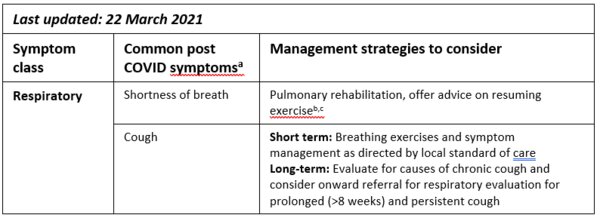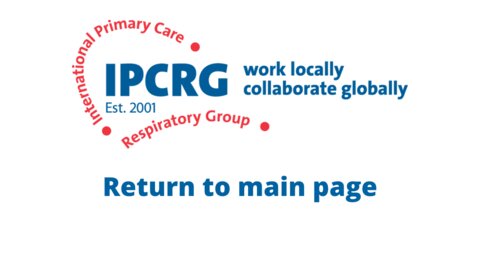How do we manage post-COVID respiratory symptoms?
What the research says:
For some patients, post-COVID symptoms may persist for weeks/months after recovery from acute illness. Continuing symptoms and clinical sequalae may be experienced by both hospitalised and non-hospitalised patients. Common respiratory symptoms include shortness of breath and cough. Clinical sequalae may include pulmonary embolism and pulmonary fibrosis. There are currently no specific guidelines on the optimal management of persistent respiratory symptoms among patients following COVID-19 infection. Anosmia is emerging as a common and troublesome persistent symptom and studies are ongoing to evaluate potential management strategies. The WHO recommends tailored, individualised management including pulmonary rehabilitation where appropriate.
What this means for your clinical practice:
- Reassure patients that for most people symptoms will resolve over weeks/months.
- Management of patients with persistent respiratory symptoms following acute COVID-19 illness should focus on symptom relief and careful monitoring for the emergence of serious sequalae such as pulmonary embolism and pulmonary fibrosis.
- Shortness of breath:
- Pulmonary rehabilitation may be beneficial for patients with persistent shortness of breath or deconditioning and they should be offered advice on the importance of resuming exercise
- Any rehabilitation programme should be careful designed around the individual needs of the patient, taking particular account of the presence of post-COVID fatigue. If present, this should be managed as for chronic fatigue syndrome with advice and support on improving quality of rest, energy conservation, relaxation training and pacing techniques. Consider referral for further neurological evaluation
- Consider cognitive behaviour therapy to address negative beliefs
- Cough:
- Dry, tickly cough: Educate and support patients to practice diaphragmatic breathing or other controlled breathing exercise. Consider a proton pump inhibitor if reflux is suspected
- Productive cough: Educate patients on breathing techniques and the importance of clearing secretions from the lungs. Monitor for signs of infection and educate patients on the need to report any changes in sputum appearance
- Chronic cough (persisting beyond 8 weeks from the acute illness): Evaluate for causes of chronic cough and consider referral for respiratory evaluation
- For patients who required inpatient care for their acute COVID-19 illness consider a follow-up X-ray at 12 weeks post-discharge.
- Evaluate and consider referral for respiratory evaluation for suspected PE or pulmonary fibrosis.
aNational COVID-19 Clinical Evidence Taskforce. Caring for people with COVID-19. Available at: https://covid19evidence.net.au/. Accessed March 2021 bGreenhalgh T, et al. BMJ 2020;370:m3026. Available at: https://www.bmj.com/content/bmj/370/bmj.m3026.full.pdf. Accessed March 2021. cWHO. COVID-19. Clinical Management. Living Guidance, 25 January 2021. Available at: https://www.who.int/publications/i/item/WHO-2019-nCoV-clinical-2021-1. Accessed March 2021
Resource information
- COVID-19
- Long COVID
- Disease management

